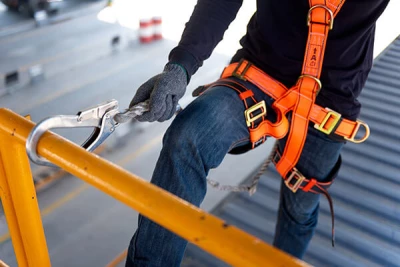Pressure Dressings
Published 6.6.2022
We all know that serious injuries can occur anywhere and at any time. When they do occur, they often involve the loss of blood, and we need to be prepared to control that element to minimize suffering and to preserve life. The most effective way to control hemorrhaging is to use pressure and elevation. When you think of applying pressure, you probably think of holding a gauze pad against a wound with your hand (hopefully while wearing gloves). The problem with holding direct pressure manually is at some point you will have to release pressure, either due to fatigue or to address other life-threatening concerns. Therefore, a pressure dressing will be a better option to control the bleeding.
Here are some initial steps you should follow, if you or someone you're with has a deep wound that is profusely bleeding.
- Call for emergency medical help to come to you or decide how to get the wounded person to emergency medical help
- If necessary, expose the entire wound by removing clothing around it, you may have to cut the clothing away. If clothing is stuck to the wound, work around it.
- Don't try to wash the wound or remove any impaled objects.
- Apply a dressing over the wound. If you don't have first-aid kit with sterile, non-stick gauze, use the cleanest, most absorbent cloth you have.
- Wrap a longer piece of cloth around the limb over your absorbent dressing and tie the ends together with a secure but adjustable knot. You want the pressure to be enough to stop the bleeding, but not so tight as to act as a tourniquet. As a tightness test you should be able to the steps above and if available, you can use an elastic pressure bandage like an ACE wrap.
- Check the person's injured limb for signs of decreased circulation, loosen the bandage.
- Elevate the wound site above the heart without causing further harm.
- Check often to make sure bleeding has stopped.
There are some pre-made commercial dressings that come with great pedigrees, such as the Israeli Bandage. These bandages use a small plastic frame to focus pressure directly on the wound. Some dressings such as QuikClot, come with an additive called hemostatic agents. The additives stimulate clotting five times faster than the body's natural process.
Remember This!
If blood soaks through your bandage, add more gauze or cloth, and apply more pressure. Don't remove the dressing to check and see if it's still bleeding, this will cause the clot that is forming to be broken.
Tourniquets
Published 6.13.2022
No one wants to be at the center of a medical emergency. But accidents, natural disasters, and shootings happen – and they happen without warning. Emergency situations like these turn average citizens into first responders in an instant. Being prepared could be all that you need to save a life.
When a traumatic injury on an arm or leg leads to rapid blood loss, a properly applied tourniquet is the most important piece of equipment you could have. A tourniquet is a safe and effective way to control bleeding however, it is only meant as a stop-gap measure to buy time while waiting for advanced traumatic care to arrive.
How to apply a tourniquet
- Immediately call for emergency medical help or instruct others to do it.
- Before you apply a tourniquet, it is important that you tell the injured person that this is going to be painful, but it is needed to sustain life.
- Cut or remove clothing so that the tourniquet can be applied to bare skin.
- Place the tourniquet as high on the injured limb nearest the armpit or groin as you can, to suppress the supplying arteries.
- Never place a tourniquet on a joint or directly on the wound.
- Pull the "tail" strap tight and twist the windlass until the flow of bright red blood stops.
- Secure the windlass to prevent loosening and note the time the tourniquet was applied.
- If bleeding restarts or the tourniquet is ineffective, apply more pressure and tighten the tourniquet again, but never remove it.
- If the bleeding still does not stop, and a second tourniquet is available, apply the second tourniquet below the first one.
- Continue to care for the person, monitor, and be prepared to treat for shock.
Just like pressure dressings, there are numerous commercial tourniquets available, such as the CAT Tourniquet, which can be easily applied with one hand.
Remember This!
Sometimes you may be faced with an emergency, and you may not be able to get a hold of tourniquet in a timely manner. In such cases making an improvised tourniquet may be necessary to help control bleeding. To make an effective tourniquet you will need 3 things, material, a windlass, and a securing mechanism. Your material should be at least 1 ½” wide and the windless should be sturdy enough not to break when under pressure and the securing mechanism can be anything that holds the windless in position.
Treating for Hypovolemic Shock
Published 6.20.2022
Shock is a life-threatening medical condition that is essentially a decrease in blood flow to the brain and other important organs. Shock can arise in several situations, including due to uncontrolled bleeding from a traumatic injury. This is known as hypovolemic shock. Blood carries oxygen and other essential substances to your organs and tissues. When heavy bleeding occurs, these substances are lost more quickly than they can be replaced. There’s not enough blood flow to the organs in your body, and they begin to shut down.
As your heart shuts down and fails to circulate an adequate amount of blood through your body, symptoms of shock occur. Blood pressure plummets and there’s a massive drop in body temperature, which can be life threatening.
Signs & Symptoms of shock vary depending on circumstances and may include,
- Cool and clammy skin
- Rapid breathing
- Weakness and fatigue
- Anxiousness
- Pale or ashen skin
- Nausea or vomiting
- Dizziness or fainting
- Agitation
- Rapid pulse
- Enlarged pupils
- Altered mental state
- Altered behavior
If you suspect someone is in shock, seek emergency medical care by calling 911 or the local emergency number immediately. Then, take the following steps:
- Begin CPR if the person shows no signs of life, such as breathing, coughing, or movement
- Treat any obvious injuries, starting with the most life threatening
- Avoid moving the person if you suspect a head, neck, or back injury
- Keep the person warm to avoid the onset of hypothermia
- If the person vomits or begins bleeding from the mouth, turn them onto their side to prevent choking, unless you suspect a spinal injury.
- Do NOT remove any impaled object
- Do NOT let the person eat or drink anything
- Do NOT raise the person's head
- Keep the person still and do not move them unless necessary





